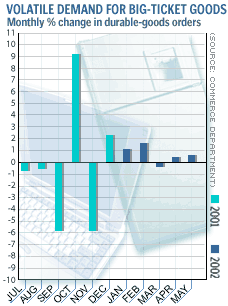
NEW YORK (CNN/Money) - Demand for durable goods made in U.S. factories rose in May, the government said Wednesday, another sign the manufacturing sector continued to recover after a long slump.
And a separate report showed new home sales hit a record level in May, following Tuesday's report of near-record existing-home sales, offering comfort to consumers who are finding Wall Street to be a house of horrors.
The Commerce Department reported that orders for goods made to last three years or longer, such as cars and computers, rose 0.6 percent in May to $173.2 billion following a twice-revised 0.4 percent gain in April. Economists surveyed by Briefing.com expected durable-goods orders to rise 0.5 percent.
"We've seen, over the past seven months or so, orders stabilize or improve slightly, compared to a big decline last year," said Gary Thayer, chief economist at A.G. Edwards. "Orders are rising relative to inventories, and that's a positive sign for capital spending."
In a separate report, the Commerce Department said new home sales jumped 8.1 percent to a 1.03 million-unit annual rate in May, the biggest on record, compared with 951,000 in April. Economists surveyed by Briefing.com expected the pace of new-home sales to slump to 920,000.

The data barely eased the pain of U.S. stock prices, which were lower on the news late Tuesday that WorldCom (WCOM: Research, Estimates) would have to restate its financial results to account for billions of dollars in improper bookkeeping. Treasury bond prices made big gains.
The news came as the Federal Reserve began the second day of a two-day meeting to discuss the strength of the economy and set policy for short-term interest rates. The central bank cuts rates, as it did 11 times in 2001, to spur spending and fight economic weakness. It raises rates to fight inflation.
The Fed has left rates alone so far this year and is widely expected to do so again Wednesday, since the strength of the economy's recovery from a recession that began in March 2001 still is in doubt.
In fact, the stock market's reaction to the WorldCom news stirred some speculation that the Fed could actually cut rates on Wednesday, out of concern for the strength of consumer confidence, which already seems to have been weakened by other corporate scandals, terror threats and more. But most economists dismissed the idea as a long shot.
"The Fed really comes in in situations where the capital markets stop functioning. This not that situation," said Brown Brothers Harriman economist Lara Rhame, formerly an economist at the Fed. "They're functioning just fine -- they're just really negative."
Greenspan and other economists have said that business spending will ultimately decide the recovery's strength. A slump in business spending, following the boom of the late 1990s, triggered an 18-month recession in the manufacturing industry, more than a million job cuts and the broader economic downturn.
Strength in orders for durable goods could be a sign that business spending is on the rebound, especially the 3.3 percent gain in non-defense capital goods, which was the biggest jump since a 3.9-percent gain in December 2001.
| |
 Related links
Related links
| |
| | |
| | |
|
Orders for computers and electronics jumped 1 percent, including a 1.6-percent gain in orders for communications equipment.
While business spending slumped, consumer spending, which makes up about two-thirds of the U.S. economy, was strong, supported in part by a red-hot housing market last year.
Persistently low mortgage rates drove demand for homes and pushed prices higher. That eased the pain of a volatile stock market, making consumers feel wealthier, while a boom of refinancing put more cash in people's pockets.

|

